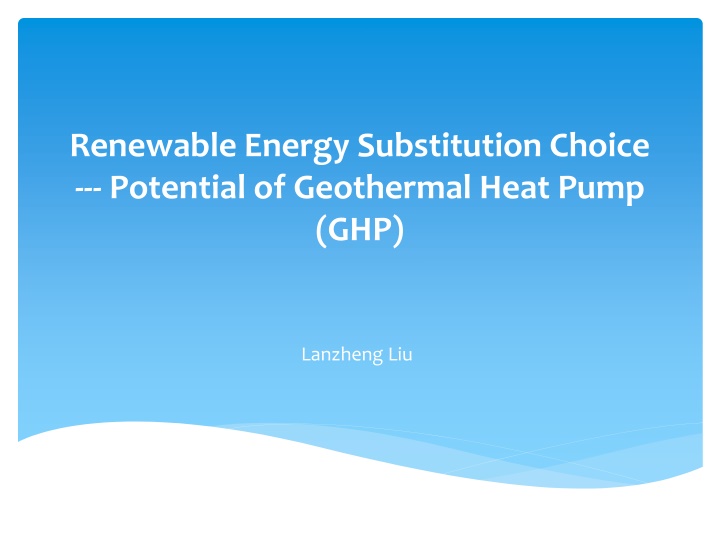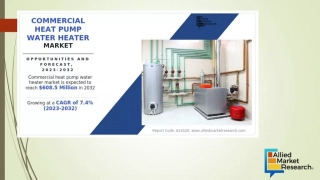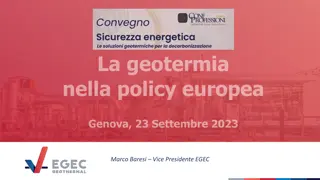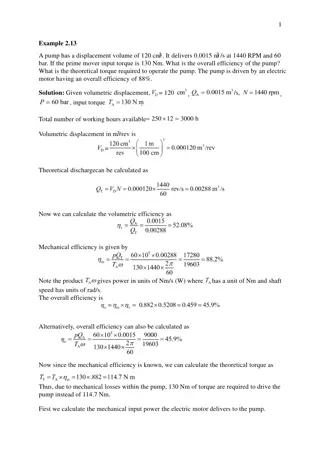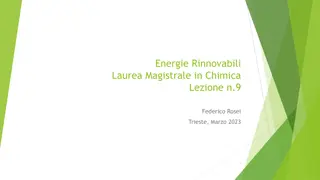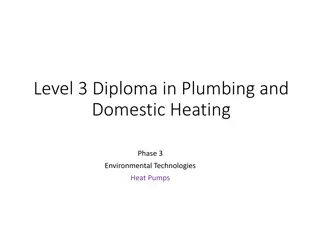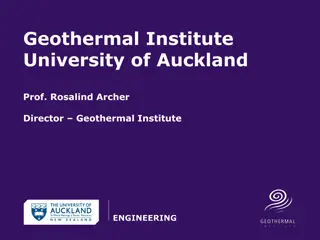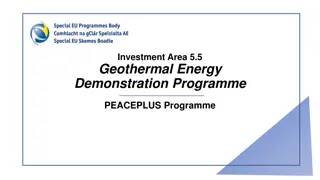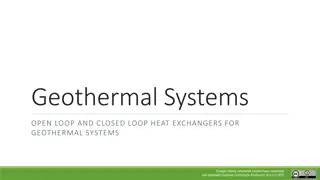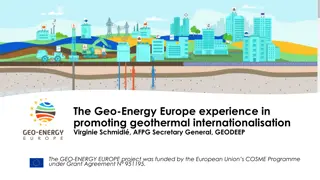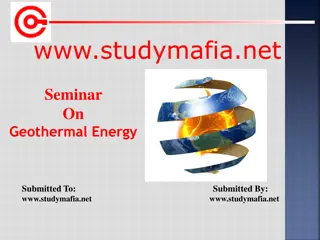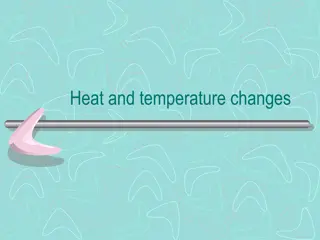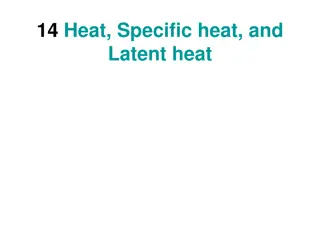Geothermal Heat Pump: Potential and Cost Efficiency
Geothermal heat pumps offer a promising renewable energy solution for efficient heating and cost savings. Explore how GHP functions, its impact on energy consumption, and potential savings through tax credits. Learn about the benefits of combining electrical space heating with GHP in regions like New England and the Middle Atlantic. Discover the economic implications, utility pricing considerations, and the role of states in covering maintenance fees.
Download Presentation

Please find below an Image/Link to download the presentation.
The content on the website is provided AS IS for your information and personal use only. It may not be sold, licensed, or shared on other websites without obtaining consent from the author.If you encounter any issues during the download, it is possible that the publisher has removed the file from their server.
You are allowed to download the files provided on this website for personal or commercial use, subject to the condition that they are used lawfully. All files are the property of their respective owners.
The content on the website is provided AS IS for your information and personal use only. It may not be sold, licensed, or shared on other websites without obtaining consent from the author.
E N D
Presentation Transcript
Renewable Energy Substitution Choice --- Potential of Geothermal Heat Pump (GHP) Lanzheng Liu
Content Introduction Cost Efficiency Saving Improvements
How Geothermal Heat Pump (GHP) Functions <302 Fahrenheit Source for geothermal heat pump (GHP) Source: https://www.renewableenergyworld.com/2016/02/24/the-hidden-genius-of-geothermal-hvac- systems/#gref
Duck Curve Actual duck curve shown in brown, representing data from March 27, 2017 in Los Angeles Department of Water and Power territory. The net load (brown) represents the load without solar energy (dotted blue) minus the available solar energy (orange) represents the load with solar energy . Behdad, K., Joan, O., & Lauren, C. (2020)
A) Keep making profit? B) Not increasing utility price? C) States cover extra maintaining fee?
Cost of Energy # of Housing Units (Million) Per housing unitEnergy Consumption ($) New England 5.6 $2,186 Middle Atlatic 15.4 $2,055 Single-family 10.8 $2,974 Apartments in buildings with 2-4 units 3.2 $1,105 Apartments in buildings with 5 or more units 4.7 $834 Natural Gas 10.6 $2,073 Electricity 6.8 $1,963 Fuel Oil 2.5 $2,385 Source EIA: 2015 statistics survey of Main Space Heating Fuel
Natural Gas Transformation & Electricity Transmission Losses In Gas Transformation(Million) Direct Losses $513 Sample Massachusetts Bill Distribution % CO2 Emission $1.07 35.18 Total $514.07 Stranded Costs 6.54 Transmission 9.54 Renewable Energy 0.33 Losses In Electric Transmission (Billion) Energy Cons 1.67 Direct Losses $5.53 Supply/Energy 46.74 CO2 Emission $0.63 Total $6.16
Electrical Space Heating Combined With GHP (New England and Middle Atlantic) $1,963 $6Billion Saving/Year $981.5
EXTRA Saving Renewable Energy Tax Credits 22% for systems placed in service after 12/31/2020 and before 01/01/2022 Expires: December 31, 2021 Geothermal Heat Pumps Requirements Must meet the requirements of the ENERGY STAR program which are in effect at the time of the expenditure. Tax credits includes installation costs. The home served by the system does not have to be the taxpayer's principal residence. Water-to-Air Water-to-Water Closed Loop: Closed Loop: EER >= 17.1 EER >= 16.1 COP >= 3.6 COP >= 3.1 Open Loop: Open Loop: EER >= 21.1 EER >= 20.1 COP >= 4.1 COP >= 3.5 Definitions: COP (Coefficient Of Performance) - of a heat pump is the ratio of the change in heat at the "output" (the water reservoir of interest) to the supplied work. EER (Energy Efficient Ratio) - The higher the EER rating, the more energy efficient the equipment is. This can result in lower energy costs. This DOE site can show how to calculate potential energy costs savings of a more efficient unit. Direct Expansion EER >= 16 COP >= 3.6 energystar.gov: Tax Credits for Renewable Energy
Tax Credits for Home Builders: Federal Tax Credits for Builders of Energy Efficient Homes The Federal Energy Policy Act of 2005 established tax credits of up to $2,000 for builders of new energy-efficient homes. The tax credit is available for homes built/manufactured in the United States between January 1, 2018, and December 31, 2020 Energy Efficiency Requirements Home builders are eligible for a $2,000 tax credit for a new energy efficient home that achieves 50% energy savings for heating and cooling over the 2006 International Energy Conservation Code (IECC) and supplements. At least 1/5 of the energy savings has to come from building envelope improvements. This credit also applies to contractors of manufactured homes conforming to Federal Manufactured Home Construction and Safety Standards and meeting the same energy efficiency requirements. There is also a $1,000 tax credit to the producer of a new manufactured home conforming to Federal Manufactured Home Construction and Safety Standards and achieving 30% energy savings for heating and cooling over the 2006 IECC and supplements (at least 1/3 of the savings had to come from building envelope improvements). Alternatively, a manufactured home also qualifies for a $1,000 tax credit if it meets ENERGY STAR requirements. Please note that, with the exception of the tax credit for an ENERGY STAR certified manufactured home, these tax credits are not directly linked to ENERGY STAR certification. Therefore, a builder of an ENERGY STAR certified home may be eligible for a tax credit but it is not guaranteed. Certification The Internal Revenue Service (IRS) has issued guidance to provide information about the certification process that a builder must complete to qualify for the credit. The guidance also provides for a public list of software programs that may be used in calculating energy consumption for purposes of obtaining a certification. energystar.gov: Tax Credits for Residential Renewable Energy
Tax Deductions for Commercial Buildings: A tax deduction of up to $1.80 per square foot is available to owners or designers of commercial buildings or systems that save at least 50% of the heating and cooling energy as compared to ASHRAE Standard 90.1-2007 (or 90.1-2001 for buildings or systems placed in service before January 1, 2018). The deduction is available for buildings or systems placed in service after December 31, 2017 through December 31, 2020. Partial deductions of up to $.60 per square foot can be taken for measures affecting any one of three building systems: the building envelope, lighting, or heating and cooling systems. energystar.gov: Tax Credits for Commercial Building
Cost of GHP (With full credits) $10,000 Pay back reduced from 10 to 6 years with tax credits 25 30 years life cycle Potential $144 Billion saving in total $7,800 $5,800
Improvement Tax Credits for Residential Energy Efficiency: 10% of cost up to $500 or a specific amount from $50-$300. Include GHP! GHP has 30-50% higher initial capital cost (a) Consume less energy to operate; (b) they tap the earth or groundwater, a more stable energy source than air; (c)they do not require supplemental heat during extreme low outside temperature; (d) they use less refrigerant; (e) they have a simpler design and consequently less maintenance and; (f) they do not require the unit to be located where it is exposed to weathering. Hepbasli, A., & Akdemir, O. (2004) GHP has 10 to 15 years longer life time than air source heat pump
Suggestion Explore different business models instead of individual installation Overcoming barrier of high upfront cost Analogous to solar Power purchase agreement Lease New subsidies
Reference 1. Apply for EERE Funding Opportunities. (n.d.).Retrieved from https://www.energy.gov/eere/funding/apply- eere-funding-opportunities Behdad, K., Joan, O., & Lauren, C. (2020). Utilizing Highway Rest Areas for Electric Vehicle Charging: Economics and Impacts of Renewable Energy Penetration in California. UC Davis. doi: 10.7922 Brenn, J., Soltic, P., & Bach, C. (2010). Comparison of natural gas driven heat pumps and electrically driven heat pumps with conventional systems for building heating purposes. Energy and Buildings, 42(6), 904 908. doi: 10.1016/j.enbuild.2009.12.012 Esen, H., Inalli, M., & Esen, M. (2006). Technoeconomic appraisal of a ground source heat pump system for a heating season in eastern Turkey. Energy Conversion and Management, 47(9-10), 1281 1297. doi: 10.1016/j.enconman.2005.06.024 Federal Income Tax Credits and Other Incentives for Energy Efficiency. (n.d.). Retrieved from https://www.energystar.gov/about/federal_tax_credits Geothermal Heating and Cooling Technologies. (2016, December 19). Retrieved from https://www.epa.gov/rhc/geothermal-heating-and-cooling-technologies 2. 3. 4. 5. 6. 7. Heidrich, M. (2016). Bounded energy exchange as an alternative to the third law of thermodynamics. Annals of Physics, 373, 665 681. doi: 10.1016/j.aop.2016.07.031 Hepbasli, A., & Akdemir, O. (2004). Energy and exergy analysis of a ground source (geothermal) heat pump system. Energy Conversion and Management, 45(5), 737 753. doi: 10.1016/s0196-8904(03)00185-7 N. Galanis, E. Cayer, P. Roy, E.S. Denis and M. D silets. (2009 february 12). Electricity Generation from Low Temperature Sources. Journal of Applied Fluid Mechanics,2(2), 55-67, 2009, 55-67. doi:1735-3645 Sanner, B. (1993). Ground Coupled Heat Pumps with Seasonal Cold Storage. Heat Pumps for Energy Efficiency and Environmental Progress, 301 308. doi: 10.1016/b978-0-444-81534-7.50041-3 8. 9. 10.
